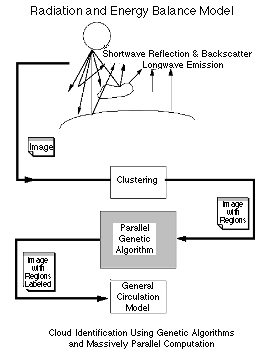 Return to the PREVIOUS PAGE
Return to the PREVIOUS PAGEObjective: Given multispectral satellite images, classify the observable clouds with respect to an appropriate meterological taxonomy.
Approach: The search paradigm known as "genetic algorithms" or, more generally, "evolutionary computation," is employed in conjunction with a high-speed, multi-processor computer. As a separate step, using clustering and not genetic algorithms, the image is divided into regions and those regions believed to be clouds are identified. A representative sample consisting of three of the five available radiometer measures of each cloud region is used as input to the genetic algorithm. The genetic algorithms assigns an identification consistent with the measure and general meterological restrictions.
Accomplishments: Prior to this reporting period, a parallel GA had been implemented on the Maspar and a test suite of images obtained. During this reporting period, the semantic net (a formoof knowledge representation) has been implemented as part of the fitness function evaluation and initial feature selection has been accomplished. While neither the form of the semantic net nor the feature set is final, this makes the package complete.
Ground truth for the specific images in the test suite is an issue. Progress was made in establishing it by working with Dr. Sonia Gallegos, an expert in cloud identification. Dr. Gallegos is with the Naval Research Laboratory.

Significance: Given the sparseness of land-based observations, it is not possible to definitively answer the simple question: Is cloudiness increasing or decreasing? The ability to automatically scan and categorize clouds will make possible the accumulation of meaningful data on this issue. Because the objective is more than to distinguish cloud from earth surface, even more detailed data will be available. This will make it possible to construct GCMs (Global Circulation Models) that are more reliable. GCMs are important in weather forecasting.
Status/Plans: A genetic algorithm that executes on the 16,000 processor Maspar MP-1 is operational. Test images consist of satellite radiometer data from the western states of the U.S. The segmentation method is rudimentary but satisfactory. While only three spectral measurements are being used there are more potential features than are obvious (e.g., ratios between spectral bands). The best features to employ for discrimination is now being investigated. The step that follows is to determine the scope and method of incorporating general meterological knowledge and constraints. A semantic net (a method from artificial intelligence for encoding symbolic information) is anticipated to be the tactic used.
Point of Contact:
 Return to the PREVIOUS PAGE
Return to the PREVIOUS PAGE